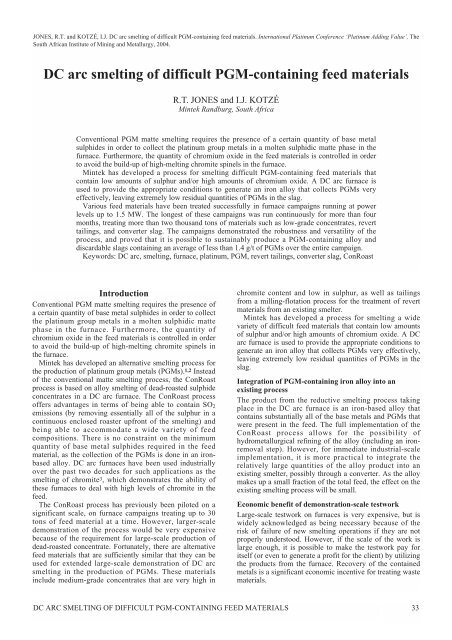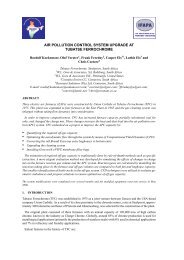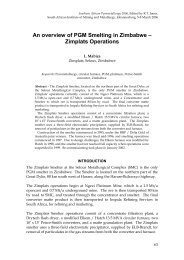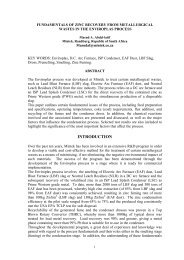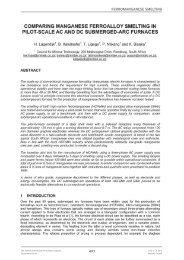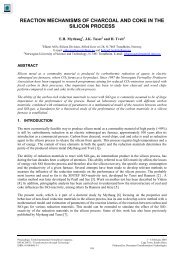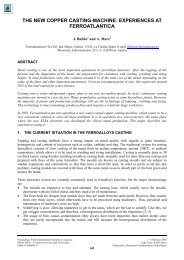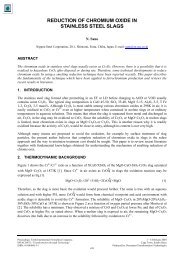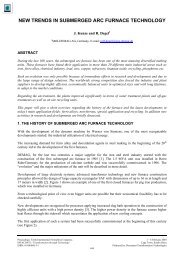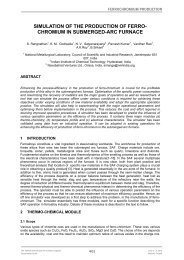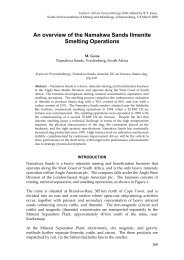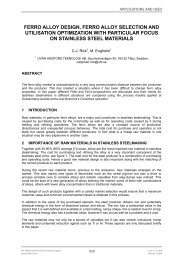DC arc smelting of difficult PGM-containing feed materials - saimm
DC arc smelting of difficult PGM-containing feed materials - saimm
DC arc smelting of difficult PGM-containing feed materials - saimm
Create successful ePaper yourself
Turn your PDF publications into a flip-book with our unique Google optimized e-Paper software.
content in slag over the first two months <strong>of</strong> the campaignwas 0.8 g/t. After this, there was a deliberate attempt tooperate the furnace under slightly less reducing conditionsin order to produce less alloy (therefore higher grade) thanwas done initially. During the <strong>smelting</strong> <strong>of</strong> revert tailings todate, the quantity <strong>of</strong> alloy produced was equivalent to 11%<strong>of</strong> the mass <strong>of</strong> the dried revert tailings fed to the furnace(i.e. about 9% <strong>of</strong> the mass <strong>of</strong> the revert tailings asdelivered). The maximum daily throughput was 30.5 tons<strong>of</strong> dried revert tailings. Typical <strong>feed</strong> rates were around oneton per hour. Very high recoveries <strong>of</strong> <strong>PGM</strong>s were obtained.Some aspects <strong>of</strong> the furnace operation are summarized inTable II. The anthracite addition, and the quantity <strong>of</strong> alloy,slag, and dust produced are all expressed relative to themass <strong>of</strong> the <strong>PGM</strong>-<strong>containing</strong> <strong>feed</strong> material, as are thespecific energy requirement <strong>of</strong> the process (excludinglosses from the furnace shell) and the electrodeconsumption. (Note that, because <strong>of</strong> the addition <strong>of</strong> slagadditives during the converter-slag-only operation, thepercentages <strong>of</strong> the alloy, slag, and dust total more than100% when expressed relative to the converter slag fed tothe furnace.)UG2 concentrate was processed together with a smallquantity <strong>of</strong> converter slag (in a 75:25 ratio by mass). Itshould be noted that this generates slags very similar incomposition to those produced when <strong>smelting</strong> reverttailings. Smelter concentrate sweepings were also treated invarying ratios together with converter slag, culminatingwith the treatment <strong>of</strong> converter slag on its own. Because <strong>of</strong>the non copper-cooled furnace, a conservative mode <strong>of</strong>operation dictated that the FeO content <strong>of</strong> the slag be keptto moderate levels, and this required very strongly reducingconditions when <strong>smelting</strong> only converter slag. This resultedin too much alloy being produced, and so was not found tobe an ideal candidate for this process (except perhaps if rununder much less reducing conditions in a copper-cooledfurnace). Revert tailings were treated on their own. Theweighted compositions <strong>of</strong> the slags produced in the variousmodes <strong>of</strong> operation are listed in Table III. The <strong>PGM</strong> contentwas analysed by fire assay, and so represents theapproximate total <strong>of</strong> Pt + Pd + Rh + Au. The average slagtapping temperatures for the various conditions are 1559,1587, 1530, 1509, 1517, and 1554ºC respectively. Theweighted compositions <strong>of</strong> the alloy produced during thevarious periods are listed in Table IV, but these are moresusceptible to variation, as the amount <strong>of</strong> alloy produced issmall relative to the amount inside the furnace at any time.Note that there wasn’t yet sufficient alloy produced to beable to tap during the treatment <strong>of</strong> the UG2 concentrate, sono alloy composition is reported for this period (although itwould be expected to be similar to the alloy produced fromrevert tailings).Table IISummary <strong>of</strong> some aspects <strong>of</strong> the furnace operation, under various conditions<strong>PGM</strong>-<strong>containing</strong> <strong>feed</strong> Tons processed % Anthracite % Alloy % Slag % Dust MWh/ton Electrode kg/ton75% UG2 conc. + 25% converter slag 18 4.8 0.6175% Concentrate + 25% converter slag 34 3.5 0.5350% Concentrate + 50% converter slag 72 7.6 22 60 4.6 0.60 2.925% Concentrate + 75% converter slag 30 7.9 0.65Converter slag 279 10.8 28 77 2.4 0.76 1.7Revert tailings >1500 5.0 11 77 4.7 0.70 2.3Table IIISlag composition, mass % (<strong>PGM</strong> listed in g/t for Pt + Pd + Rh + Au)Material treated Al 2 O 3 CaO Co Cr 2 O 3 Cu FeO * MgO Ni S SiO 2 <strong>PGM</strong> Total75% UG2 conc. + 25% converter slag 4.5 4.4 0.03 4.2 0.07 21.1 20.2 0.11 0.26 43.3 0.6 98.175% Concentrate + 25% converter slag 4.2 5.3 0.06 2.7 0.14 25.4 15.6 0.18 0.51 43.6 0.9 97.750% Concentrate + 50% converter slag 4.2 5.3 0.03 3.7 0.10 21.8 13.2 0.05 0.47 48.6 0.6 97.625% Concentrate + 75% converter slag 3.5 4.2 0.04 3.8 0.13 29.6 9.6 0.06 0.57 48.6 0.6 100.1Converter slag 3.5 2.6 0.04 5.1 0.13 33.5 12.8 0.03 0.57 41.0 0.6 99.4Revert tailings 4.9 7.4 0.04 3.1 0.07 28.0 12.7 0.10 0.34 43.3 1.6 100.1* Total Fe expressed as FeOTable IVAlloy composition, mass %Material treated C Co Cr Cu Fe Ni S Si Total75% Concentrate + 25% converter slag 0.03 0.66 0.20 6.9 61.9 10.3 18.5 0.16 98.750% Concentrate + 50% converter slag 0.09 0.74 0.82 4.8 71.4 8.6 12.1 0.10 98.725% Concentrate + 75% converter slag 0.05 0.79 0.35 4.6 73.8 11.8 11.8 0.02 99.2Converter slag 0.12 0.96 0.31 3.0 86.2 5.3 4.6 0.16 100.7Revert tailings 0.12 1.21 0.21 2.1 83.7 8.0 3.7 0.51 99.6<strong>DC</strong> ARC SMELTING OF DIFFICULT <strong>PGM</strong>-CONTAINING FEED MATERIALS 35
Table VRecoveries <strong>of</strong> elements to the alloy, % <strong>of</strong> <strong>feed</strong>Material treated Co Cr Cu Fe Ni S S to gas75% UG2 Conc. + 25% converter slag 85 - 89 50 9175% Concentrate + 25% converter slag 70 2.2 91 40 9350% Concentrate + 50% converter slag 92 13.0 96 66 99 68 2525% Concentrate + 75% converter slag 92 6.9 95 63 99Converter slag 90 2.8 88 53 98 59 18Revert tailings 81 1.4 81 36 92 47 23Of principal interest in a metal recovery process is thedeportment <strong>of</strong> the various elements to the alloy phase. Inthe furnace campaign described here, the dust that isproduced from the furnace and captured in the baghouse isall recycled back to the furnace. On that basis, as long asthe elemental accountability is good, the simplestexpression <strong>of</strong> recovery <strong>of</strong> a given element is the ratiobetween the mass <strong>of</strong> its content in the alloy divided by thecombined mass <strong>of</strong> its content in the alloy and slag. Sulphurhas to be treated differently, as we are also interested inhow much reports to the gas. The recoveries <strong>of</strong> variouselements <strong>of</strong> interest are listed in Table V. (Note that therecoveries reported for the first condition—treating UG2concentrate—had to be estimated on the basis <strong>of</strong> <strong>feed</strong> andslag, rather than alloy and slag, as there was no alloy tappedat that stage.)ConclusionsA large-scale demonstration has been carried out over aperiod <strong>of</strong> more than four months, showing the viability <strong>of</strong> a<strong>DC</strong> <strong>arc</strong> <strong>smelting</strong> process for the treatment <strong>of</strong> <strong>difficult</strong> <strong>PGM</strong><strong>containing</strong><strong>feed</strong> <strong>materials</strong>. The <strong>smelting</strong> process has beenshown to be sufficiently robust for industrial application.The collection <strong>of</strong> <strong>PGM</strong>s in an iron alloy is efficient, andthis provides grounds for confidence in the ConRoast<strong>smelting</strong> process.Large-scale demonstration testwork can be economicallyfavourable, in that it is possible to generate sufficientproduct that the work can pay for itself or perhaps even bepr<strong>of</strong>itable.AcknowledgementsThis paper is published by permission <strong>of</strong> Mintek. Theassistance <strong>of</strong> many colleagues made the development <strong>of</strong>this process possible, and their contributions are gratefullyacknowledged. Krause Ehlers and Dawie Fouriecontributed significantly to the development <strong>of</strong> the process.Tom Curr, Glen Denton, Arnold Dorfling, Trevor G<strong>of</strong>f,Kallie van Rooyen, Basi Malise, Deon Kruger, Gerald Holt,Louis Fourie and the shift teams provided an enormousamount <strong>of</strong> operational support in the running <strong>of</strong> this largescaleproject. The support <strong>of</strong> colleagues in Mintek’s HighTemperature Thermochemistry, Analytical Science, andEngineering Services divisions is also gratefullyacknowledged.References1. JONES, R.T. ConRoast: <strong>DC</strong> <strong>arc</strong> <strong>smelting</strong> <strong>of</strong> deadroastedsulphide concentrates, Sulfide Smelting 2002.Stephens R.L. and Sohn H.Y.(eds.), TMS (TheMinerals, Metals & Materials Society), Seattle, 17–21February 2002, pp. 435–456.2. JONES, R.T., BARCZA, N.A., KAIURA, G.,O'CONNELL, G., and HANNAFORD, T. Treatment<strong>of</strong> metal sulphide concentrates by roasting and <strong>arc</strong>furnace reduction, South African patent ZA 99/1285(26 February 1999), European patent EP 1 157 139B1 (9 October 2002), US patent 6,699,302 B1 (2M<strong>arc</strong>h 2004).3. JONES, R.T., BARCZA, N.A., and CURR, T.R.Plasma Developments in Africa, Second InternationalPlasma Symposium: World progress in plasmaapplications, Organized by the EPRI (Electric PowerRese<strong>arc</strong>h Institute) CMP (Center for MaterialsProduction), 9–11 February 1993, Palo Alto,California.36PLATINUM ADDING VALUE


